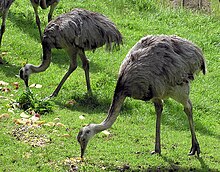Rhea (bird)
| Rheas Temporal range: -Holocene 0.126–0 Ma |
|
|---|---|
 |
|
| Two greater rheas | |
| Scientific classification | |
| Kingdom: | Animalia |
| Phylum: | Chordata |
| Class: | Aves |
| Order: | Rheiformes |
| Family: | Rheidae |
| Genus: |
Rhea Brisson, 1760 |
| Type species | |
|
Rhea americana Linnaeus, 1758 |
|
| Species | |
|
|
| Synonyms | |
|
|
The rheas /ˈriː.ə/ are large ratites (flightless birds without a keel on their sternum bone) in the order Rheiformes, native to South America, related to the ostrich and emu. There were formerly two, but now three recognized extant species: the greater or American rhea (Rhea americana), the lesser or Darwin's rhea (Rhea pennata) and the puna rhea (Rhea tarapacensis). The greater and puna rheas are currently rated as near-threatened in their native ranges, while Darwin's rhea is of least concern; a feral population of the greater rhea in Germany appears to be growing.
The genus name was given in 1752 by Paul Möhring and adopted as the English common name. Möhring named the rhea based on the Greek Titan Rhea, whose name is derived from the Greek Rhea (῾Ρέα) from έρα "ground". This was fitting, the rhea being a flightless ground bird. Depending on the South American region, the rhea is known locally as ñandú guazu (Guaraní, meaning big spider, most probably in relation to their habit of opening and lowering alternate wings when they run), ema (Portuguese), suri (Aymara and Quechua), or choique (Mapudungun). Nandu is the common name in many European languages.
...
Wikipedia
